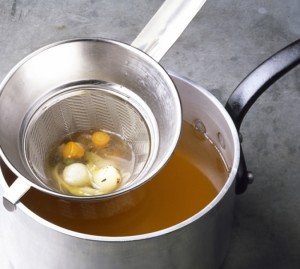Easy Ideas For Making Your Own Stock

Stock is the liquid base for many dishes, especially soups and sauces, made by simmering bones, meat or vegetables in water or wine. The differences between what people call stock and what they refer to as broth are not always clear. According to the traditional explanation, as Epicurious explains, stock is primarily flavored with bones, whereas broth takes most of its flavor from meat.The Kitchn contends that as the words are used now stock differs from broth mainly in that it has less seasoning, and thus is not especially tasty, until you make it part of a dish.
In any case, keeping stock on hand is an easy way to get a head start on preparing soups, sauces and other recipes. You can buy a variety at any grocery store, but homemade stock tastes great and, since you control the seasoning, it can help you cut down your sodium intake. Follow the tips below for preparing beef, chicken and vegetable stock, and you’ll have flavor at the ready in the freezer.
Beef stock
Making a beef stock is not difficult, but it does take time. You’ll need four pounds of beef bones; it’s best to use a mixture of meaty and marrow bones, as they will each contribute their own flavor characteristics to the stock.
- Preheat the oven to 400 degrees Fahrenheit.
- Peel and roughly chop two onions and and two large carrots.
- Place the bones and vegetables in a shallow roasting pan and roast for about 45 minutes, or until browned.
- Move the bones and vegetable into a large stock pot.
- Notice the brown bits stuck to the bottom of the roasting pan; you’ll want these for added flavor. Set the pan on the stovetop at a low heat and pour in a cup of water or wine. Stir occasionally with a metal spatula or flat whisk. After a few minutes, add the results to the stock pot.
- Add additional vegetables and flavoring, such as potatoes, parsnips, two bay leaves and 10 peppercorns. Pour in 10-12 cups of water.
- Simmer at a low heat for five hours. Avoid boiling, as this will lead to a cloudier stock.
- Strain the stock and dispose of all the solids. Refrigerate or freeze the beef stock, and you’ll have it ready for your next recipe.

Chicken stock
The preparation for homemade chicken stock is very similar to beef, but the best time to try this is when you have just roasted a whole chicken. Rather than immediately throwing out the bones and carcass after carving off all the pieces you’re serving for dinner, you can first put them to good use.
- Place the bones and carcass in the stock pot and cover them with cold water. Don’t pour in too much water because it will dilute your stock’s flavor.
- Peel and roughly chop two onions and two carrots. Chop three to four celery stalks as well.
- Add the vegetables to the pot, and include tw bay leaves and 10 peppercorns. You might also throw in some allspice, herbs, fennel, paprika or a dried chili for greater flavor.
- Simmer for about two hours. Look for the chicken to fall apart. Taste the stock every hour or so until, and continue simmering until you are happy with its flavor.
- If you want, you can skim any film from the top of the stock as it simmers for a cleaner look and taste. However, many prefer the smoothness the film contributes. Alternatively, as Epicurious suggests, you can refrigerate the stock for a few hours after it’s done and easily scrape the congealed fat from the top.
- Strain the stock, disposing of the solids. Refrigerate or freeze the chicken stock.
Vegetable stock
You’ll likely find vegetable stock quicker and even easier than the other two varieties. Again you’ll want two onions and carrots and three or four celery stalks. Throw in tomatoes, mushrooms, leeks and other vegetables according to your preferences and their availability.
- Peel the onions and carrots and roughly chop all your vegetables.
- Place the vegetables in your stock pot and cover with water. Again, keep the water minimal in order to maximize flavor.
- Stir in some fresh herbs, like parsley and thyme, a bay leaf and five to six peppercorns.
- Simmer for about an hour, stirring occasionally.
- Strain out the vegetables and freeze the stock.






Recent Comments